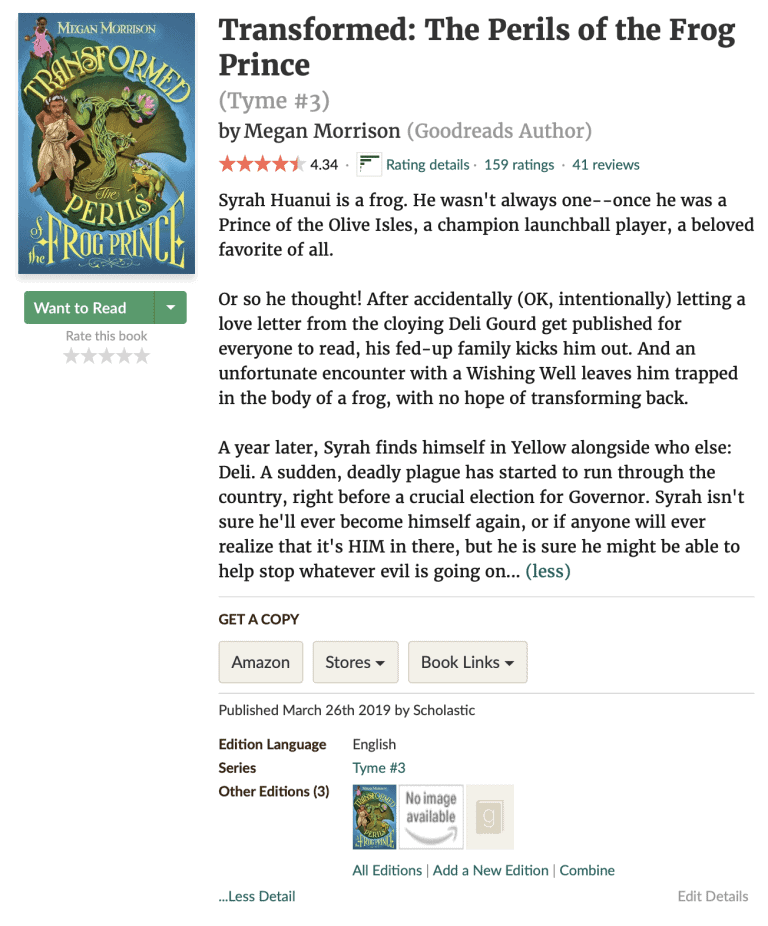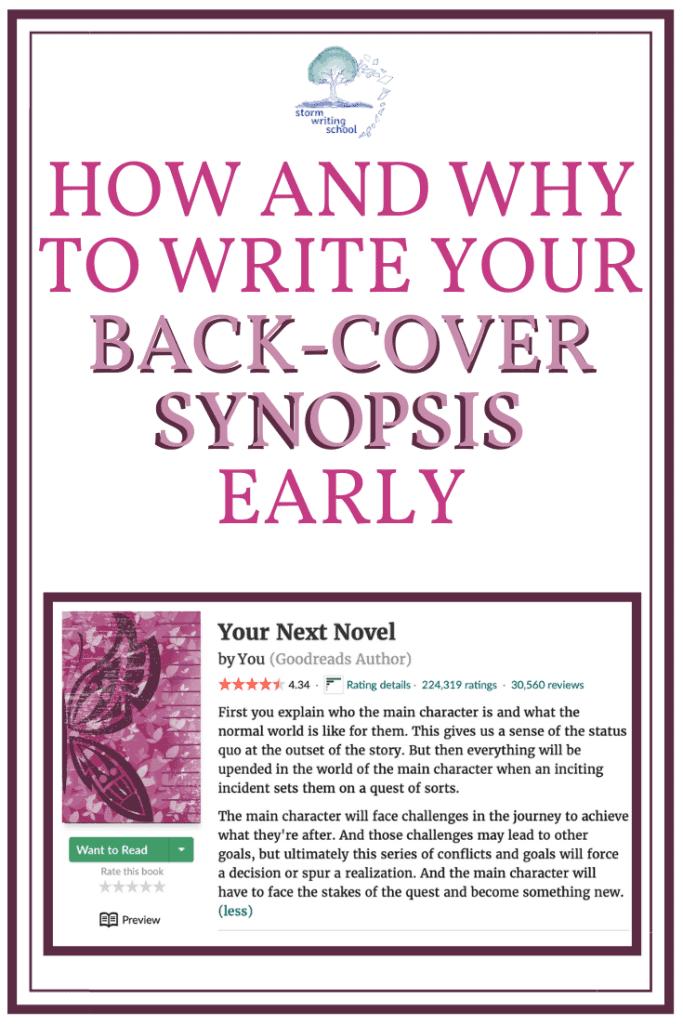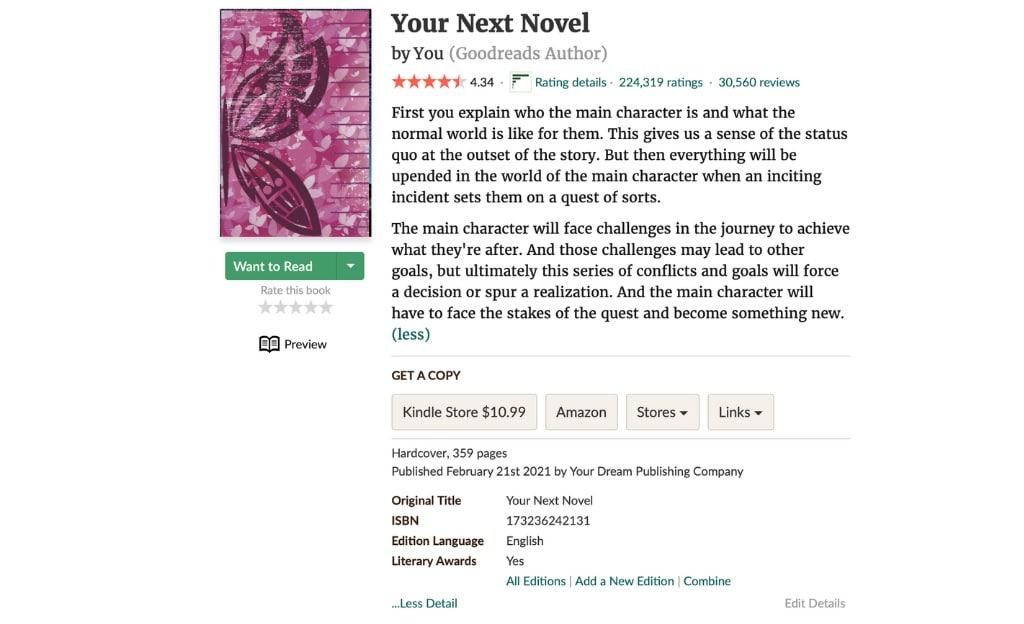Pick up a paper copy of a book and look at the back cover. You’ll find a few things there: blurbs and reviews, maybe an author bio, perhaps a tagline, and a back-cover synopsis
That short synopsis is usually about 150-200 words, and it piques the readers’ interest and gives a sense of what the book will be about. Its job is to get readers to want to read the book.
Pull up any book on Goodreads, Amazon, iBooks, or Indiebound, and you’ll usually see the back-cover synopsis written just below the title and author. Here, for instance, is a screenshot of a Goodreads page for Megan Morrison’s middle-grade novel, Transformed:

That three-paragraph synopsis is what I’m talking about here. It’s also pretty close to what you’d include in a query letter as your “hook” (see Jane Friedman for more on the hook in a query letter). And if you look at a few, you’ll start to see a pattern to them.
The Pattern
I first want to clarify that this back-cover synopsis is not the story synopsis you might send to an agent (again, it’s more like the hook in your query letter). The long synopsis is usually somewhere between 500 words and 1000 words (but look at submission guidelines!), and they spoil the entire story. They summarize it all and say what happens in the end.
This back-cover synopsis does not give away the whole story.
Here’s what you should do in the back-cover synopsis:
- Introduce the main character(s)
- Inform us of the inciting incident
- Give a sense of the character’s goal/desire
- Give an overview of the major conflicts
- Hint at how the character will be pushed to transform
Examples and Tips
#1: I Like You Just Fine When You’re Not Around
Take a look at this back-cover synopsis from Ann Garvin’s I Like You Just Fine When You’re Not Around:
Everything is falling apart in psychologist Tig Monahan’s life. Her mother’s dementia is wearing her out; her boyfriend takes off for Hawaii without her; and her sister inexplicably disappears, leaving her newborn behind.
When a therapy session goes horribly wrong, Tig finds herself unemployed and part of the sandwich generation trying to take care of everyone and failing miserably. Just when she thinks she can redefine herself on the radio as an arbiter of fairness, she discovers a family secret that nobody saw coming.
It will take everything plus a sense of humor to see her way clear to a better life, but none of that will happen if she can’t let go of her past.
- Main character: Tig Monahan
- Inciting incident: therapy session goes horribly wrong
- Goal: a better life
- Conflicts: sandwiched, failing, family secret, her past
- Push toward transformation: let go of her past
Included with the intro to the main character is an orientation to the world she lives in (her status quo) at the beginning of the story.
And note that the back-cover synopsisis is heavy on the premise.
It’s pretty typical that the intro to the character and the inciting incident take up at least half of the back-cover synopsis, if not two thirds. It then kind of flies through the goal and conflicts, and it almost always lands on the stakes-heavy challenge that will require the main character to transform.
#2: The House in the Cerulean Sea
Here’s one from The House in the Cerulean Sea by TJ Klune:
Linus Baker leads a quiet, solitary life. At forty, he lives in a tiny house with a devious cat and his old records. As a Case Worker at the Department in Charge Of Magical Youth, he spends his days overseeing the well-being of children in government-sanctioned orphanages.
When Linus is unexpectedly summoned by Extremely Upper Management he’s given a curious and highly classified assignment: travel to Marsyas Island Orphanage, where six dangerous children reside: a gnome, a sprite, a wyvern, an unidentifiable green blob, a were-Pomeranian, and the Antichrist. Linus must set aside his fears and determine whether or not they’re likely to bring about the end of days.
But the children aren’t the only secret the island keeps. Their caretaker is the charming and enigmatic Arthur Parnassus, who will do anything to keep his wards safe. As Arthur and Linus grow closer, long-held secrets are exposed, and Linus must make a choice: destroy a home or watch the world burn.
- Main character: Linus Baker
- Inciting incident: unexpectedly summoned by Extremely Upper Management
- Goal: determine the threat of the dangerous children
- Conflicts: the kids, secrets, Arthur
- Push toward transformation: the crucial choice
Note that the goal and conflicts are not laid out in a sequential, ordered list. You may get a goal, a conflict, another goal, another conflict.
Also note that a crucial choice always implies that there will be a push to transformation. In this one, we don’t exactly know how Linus will be transformed as a result of his choice, but we can feel pretty confident that this choice will have an enormous impact on him.
#3: The Rosie Project
Graeme Simsion’s The Rosie Project gives us a back-cover synopsis in two paragraphs:
Don Tillman, professor of genetics, has never been on a second date. He is a man who can count all his friends on the fingers of one hand, whose lifelong difficulty with social rituals has convinced him that he is simply not wired for romance. So when an acquaintance informs him that he would make a “wonderful” husband, his first reaction is shock. Yet he must concede to the statistical probability that there is someone for everyone, and he embarks upon The Wife Project. In the orderly, evidence-based manner with which he approaches all things, Don sets out to find the perfect partner. She will be punctual and logical—most definitely not a barmaid, a smoker, a drinker, or a late-arriver.
Yet Rosie Jarman is all these things. She is also beguiling, fiery, intelligent—and on a quest of her own. She is looking for her biological father, a search that a certain DNA expert might be able to help her with. Don’s Wife Project takes a back burner to the Father Project and an unlikely relationship blooms, forcing the scientifically minded geneticist to confront the spontaneous whirlwind that is Rosie—and the realization that love is not always what looks good on paper.
- Main character: Don Tillman
- Inciting incident: acquaintance informs him he would make a wonderful husband
- Goal: the Wife Project
- Conflicts: Rosie, the Father Project
- Push toward transformation: realization that love is not always what looks good on paper
Again, note that the intro to the character often includes an intro to their current status quo. Those intros and the inciting incident make up the whole first paragraph of this one, about 60% of the total synopsis here. Not every story will end with a realization like this one does, but that’s always a pretty good way to suggest a transformation.
Why write this thing?
To Avoid Compartmentalization
The typical trajectory for a fiction writer is 1) spend a long time writing the book, 2) switch gears entirely and do all the requisite jumping through the hoops to get an agent or pitch to one (query letter, synopsis, logline, pitch, etc.), 3) and then switch gears again to do marketing stuff.
If you write the back-cover synopsis early on in your story creation—and keep revisiting it—the changing of gears will be less shocking and abrupt. You’ll have already thought about how your book will pique reader’s interest, and you’ll have thought about how the push to transformation will appeal to people. So when it comes time to talk about why your book is one that people should read, it won’t feel so strange.
There’s a compelling case to be made that writing a book and selling it should not be so separated and compartmentalized.
It’s easy and very tempting to brush this exercise off as marketing and to look down your artist’s nose at it. But this 150-word piece of writing will help readers who would love your book find it—whether that reader is an agent, or a someone shopping for a new book to read.
To Focus and Inspire Yourself
But what’s more, when you write this back-cover synopsis early on in your writing process, it can help pique your own interest.
In fact, think about writing these back cover synopses for every good idea you get. Collect them. And then get them out later and look at them and see which ones seem like books you’d love to read.
Once you start writing your story in earnest, this brief synopsis can serve as a touchstone for you; check in with it and see how your story is adhering to or drifting from your original vision. It’s okay to allow the synopsis to change and evolve. It’s a living document.
To Test Out Ideas
You can even test out a batch of four or five synopses on friends or a writing group and get their opinions on which one they’d be most excited to read.
This is essentially what writer Ann Garvin did with her most recent novel (forthcoming in 2021). She wrote five short synopses and asked her agent to rank them. Then she went with the one her agent said was most promising. The book sold on a pre-empt.
Last week, I spoke with Ann Garvin in a livestream conversation about this approach. We recorded the conversation. Take a look at the free session here: From Pitch to Manuscript.
As we mention in the video, Ann and will followed up that session with a series of other videos to delve into the steps you can take to build out your premise into a successful story. Those course are free. To see the full list, check out this page: The From Pitch to Manuscript Sessions.






16 Responses
Great graphics. Well, that will teach me to read books without reading the back cover blurb. I loved The Rosie Project and I just realized I don’t remember ever reading the back cover blurb. I had read several recs for it and dived in. I totally think writing the blurb and even the synopsis or some form of it up front is a good idea. Interestingly for me, though, is that whenever I’ve written a solid blurb first, I’ve never gotten past writing the first few chapters, and when I can’t write the blurb, that’s when I finish the book and have to switch gears. I need to rethink what I’m doing!
If it works to help you finish the book, then stick with that process. But yeah, the shifting gears can be a drag, right?
This is a timely article. I’m working on the blurb for a book I’m not planning to write until May and publish end of August. As it’s part of a series, I want the blurb ready in time for the upcoming launch of the earlier book in the series to profit on pre-orders. I found I had to spend a bit of time fleshing the idea out in order to get the blurb written. And now the actual writing seems less daunting. Win- win!
Win-win, indeed! For those writing a series, writing the back-cover synopsis early is a very good idea.
I’m just about to this point though getting there darn slowly. Thanks for the tips.
Thank you, Jacqui. Best of luck!
Thanks, Tim. I like how you lay this out–the checklist of what the synopsis should include is really helpful, and Raimey’s right–the graphics are great.
Truth is, I’ve had a fair amount of ambivalence towards marketing-geared elements of the writing process like this. I suppose it’s something I’ve got to get past if the ultimate goal is for folks to be reading my stuff! All part and parcel.
Thanks again for laying it out clearly.
Jimmy
I’m 100% with you about the marketing-geared elements of the whole process. Hard to avoid, though.
Great examples! Thanks. Do you have some good examples for non-fiction too?
Good question. You can see something similar at play in narrative-driven nonfiction. You won’t see it as much with collections of essays or with biographies, etc. (A lot of nonfiction ends up coming into existence via a similar method, however: it lays out a proposal first–when it’s being pitched to agents–and then moves on to the full manuscript.)
Check out something like The Devil in the White City or Cheryl Strayed’s Wild and you can see a similar pattern there to the back-cover synopsis.
What a great idea to crystalize your story from the get go. I am about to start my second novel and will be adopting this approach.
Great, Naomi! Let me know how it goes!
I’ve definitely heard a few published authors make a case for “try to craft the logline, pitch, and back cover blurb before writing a rough draft” as a way of “testing the idea,” and in some cases revising the promotional items to make the “sale” easier, and then let those inform the revised outline and plan for the rough draft.
It definitely has merit, paraticularly if selling the product is a high priority.
Of course I’ve also heard some authors talk about how they write a lot of stories, and less than half are ever published. I think Brandon Sanderson has said for every story he publishes he writes 1-3 of similar length that he knows will never be suitable for the publishing world.
At the end of the day it’s all about “what works for each person,” though having many things to try certainly helps.
Great article. I’m bookmarking this one for sure. 🙂
Pays to do some filing now and again. Can’t believe I missed this. One of those great exercises that through a “limiting ” process, the possibilities are (nearly) boundless. Thank you, Tim.
Thanks, “Stan”!